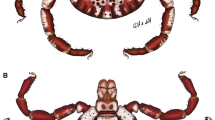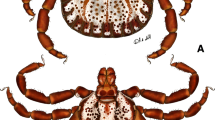Abstract
The Hainan black gibbon, Hylobates concolor hainanus,was originally believed to be endemic to Hainan Island. The authors of some recent reports suggest that the subspecies also occurs on the mainland in northeastern Vietnam (Dao Van Tien, 1983) and that it has only recently been exterminated in southwestern Guangxi Province, China (Fooden et al.,1987). Others disagree and propose that these populations should be identified as H. c. concolor (Ma and Wang, 1986; Ma et al.,1988). A female from northeastern Vietnam lived for many years at the Tierpark Berlin. This report provides a preliminary description of this adult female, demonstrating that it cannot be attributed to H.c. hainanus.In some characteristics the specimen resembles H. c. concolor,but in others it is unique. This female provides the first evidence that the distribution area of the proposed mainland population of H. c. hainanusin northeastern Vietnam also contains a previously unrecognized population which either belongs to H.c. concoloror possibly represents a new subspecies of the black gibbon (H. concolor).
Similar content being viewed by others
References
Bourret, R. (1946).Les mammiferes de l’Indochine: Les Gibbons, Laboratoire des Sciences Naturelles de l’Université Indochinoise (date approximate).
Boutan, L. (1906).Mission scientifique permanente d’exploration en Indo-Chine. Décades zoologiques: Mammiféres, Hanoi.
Chivers, D. J. (1977). The lesser apes. In Prince Rainier III of Monaco and Bourne, G. H. (eds.),Primate Conservation, Academic Press, New York, pp. 539–598.
Dao, Van Tien (1983). On the north Indochinese gibbons (Hylobates concolor) (Primates: Hylobatidae) in North Vietnam.J. Hum. Evol. 12: 367–372.
Dao, Van Tien (1985)Khao sát thÚ a mien bac Viet Nam [Scientific Results of Some Mammals Surveys in North Vietnam (1957–1971)], Scientific and Technical Publishing House, Ha Noi (in Vietnamese).
Delacour, J. (1951). La systématique des Gibbons Indochinois.Mammalia 15: 118–123.
Fischer, W. (1965).Das Jahr mit den Gibbons, A. Ziemsen Verlag, Wittenberg Lutherstadt.
Fischer, W. (1980). Einige ErgÄnzungen zur Haltung und Entwicklung des Schopfgibbons,Hylobates (Nomascus) concolor (Harlan).Milu Berlin 5(1/2): 167–193.
Fischer, W. (1981). Forschende Kamera-Farbwechsel beim Schopfgibbon.Urania Leipzig 57(10): 2–5.
Fooden, J. (1987). Type locality ofHylobates concolor leucogenys.Am. J. Primatol. 12: 107–110.
Fooden, J., Quan, G., and Luo, Y. (1987). Gibbon distribution in China.Acta Theriol. Sinica 7: 161–167.
Groves, C. P. (1972). Systematics and phylogeny of gibbons. In Rumbaugh, D. M. (ed.),Gibbon and Siamang, Vol. 1, Karger, Basel, pp. 1–89.
Groves, C. P. (1984). A new look at the taxonomy and phylogeny of the gibbons. In Preuschoft, H., Chivers, D. J., Brockelman, W. Y., and Creel, N. (eds.),The Lesser Apes. Evolutionary and Behavioural Biology, Edinburgh University Press, Edinburgh, pp. 542–561.
Groves, C. P. (1988). The taxonomy of crested or concolor gibbons.Austral. Primatol. 3(1): 33.
Haimoff, E. H. (1984). The organization of song in the Hainan black gibbon (Hylobates concolor hainanus).Primates 25: 225–235.
Harlan, R. (1826). Description of an hermaphrodite orang outang, lately living in Philadelphia.J. Acad. Nat. Sci. Philad. 5: 229–236.
International Commission on Zoological Nomenclature (1985).International Code of Zoological Nomenclature, Third Edition, A dopted by the XX General Assembly of the International Union of Biological Sciences, International Trust for Zoological Nomenclature, London.
Kloss, C. B. (1929). Some remarks on the gibbons, with the description of a new subspecies.Proc. Zool. Soc. Lond. 1929: 113–127.
Kunckel d’Herculais, J. (1884). Le Gibbon du Tonkin.Sci. Nature 2(33): 86–90.
Ma, S., and Wang, Y. (1986). The taxonomy and distribution of the gibbons in southern China and its adjacent region-with description of three new subspecies (in Chinese, with English summary).Zool. Res. 7(4): 393–410.
Ma, S., Wang, Y., and Poirier, F. E. (1988). Taxonomy, distribution, and status of gibbons (Hylobates) in southern China and adjacent areas.Primates 29(2): 277–286.
Marshall, J., and Sugardjito, J. (1986). Gibbon systematics. In Swindler, D. R., and Erwin, J. (eds.),Comparative Primate Biology, Vol. 1. Systematics, Evolution, and Anatomy, Alan R. Liss, New York, pp. 137–185.
Martin, R. (1928).Lehrbuch der Anthropologie, Vol. 2. Kraniologie, Osteologie, 2nd ed., Gustav Fischer, Jena.
Matschie, P. (1893). Die unterscheidenden Merkmale der Hylobates-Arten.Sitzungsber.Ges. naturf. Freunde Berlin 1893: 209–212.
Pocock, R. I. (1925). The gibbons of the genusHylobates.Proc. Zool. Soc. Lond. 1927(2): 719–741.
de Pousargues, E., (1904). Mammiféres de l’Indo-Chine. In Pavie, A. (ed.),Mission Pavie IndoChine 1879–1895. études diverses, III. Recherches sur l’histoire naturelle de l’Indo-Chine Orientale. Ernest Leroux, Paris, pp. 510–549.
Schilling, D. (1984). Gibbons in European zoos, with notes on the identification of subspecies of concolor gibbon. In Preuschoft, H., Chivers, D. J., Brockelman, W. Y., and Creel, N. (eds.),The Lesser Apes. Evolutionary and Behavioural Biology, Edinburgh University Press, Edinburgh, pp. 51–60.
Simonetta, A. (1957). Catalogo e sinonimia annotata degli ominoidi fossili ed attuali (1758–1955).Atti Soc. Toscana Sci. Nat. Pisa Ser. B. 64: 53–113.
Thomas, O. (1892). Note on the gibbon of the island of Hainan (Hylobates hainanus, sp. n.).Ann. Mag. Hist. 9(6): 145–146.
United States Board on Geographic Names (1964).Official Standard Names Gazetteer No. 79: Northern Vietnam, Department of the Interior, Washington, D.C.
Xu, L., Liu, Z., and Yu, S. (1983). Mammalia. In Xu, L., Liu, Z., and Yi, X. (eds.),Birds and Mammals of Hainan Island, Scientific Publishing Agency, Beijing, pp. 278–401 (in Chinese).
Author information
Authors and Affiliations
Rights and permissions
About this article
Cite this article
Geissmann, T. A female black gibbon,Hylobates concolor subspecies, from Northeastern Vietnam. Int J Primatol 10, 455–476 (1989). https://doi.org/10.1007/BF02736371
Received:
Revised:
Issue Date:
DOI: https://doi.org/10.1007/BF02736371




